NUM1204: Literature Search Protocol for Caregivers' Health Literacy
VerifiedAdded on 2022/08/21
|13
|2453
|15
Report
AI Summary
This report details a systematic literature search conducted to investigate the factors affecting the health literacy of family caregivers of older adults. The report begins with a justification of the application of evidence-based practice, highlighting its importance in providing quality healthcare. The answerable question, formulated using the PIO framework, focuses on the factors influencing caregivers' health literacy. The search strategy protocol outlines the databases used (MEDLINE, CINHL, Embase, Google Scholar), keywords, and inclusion/exclusion criteria applied to identify relevant articles published between 2014 and 2020. The search results are presented, detailing the number of articles obtained at each stage of the search process, from initial keyword searches to the final selection of relevant papers. The report concludes with a list of the selected references and the literature search strategy, including inclusion/exclusion criteria, keywords, databases, and a summary of the search history.
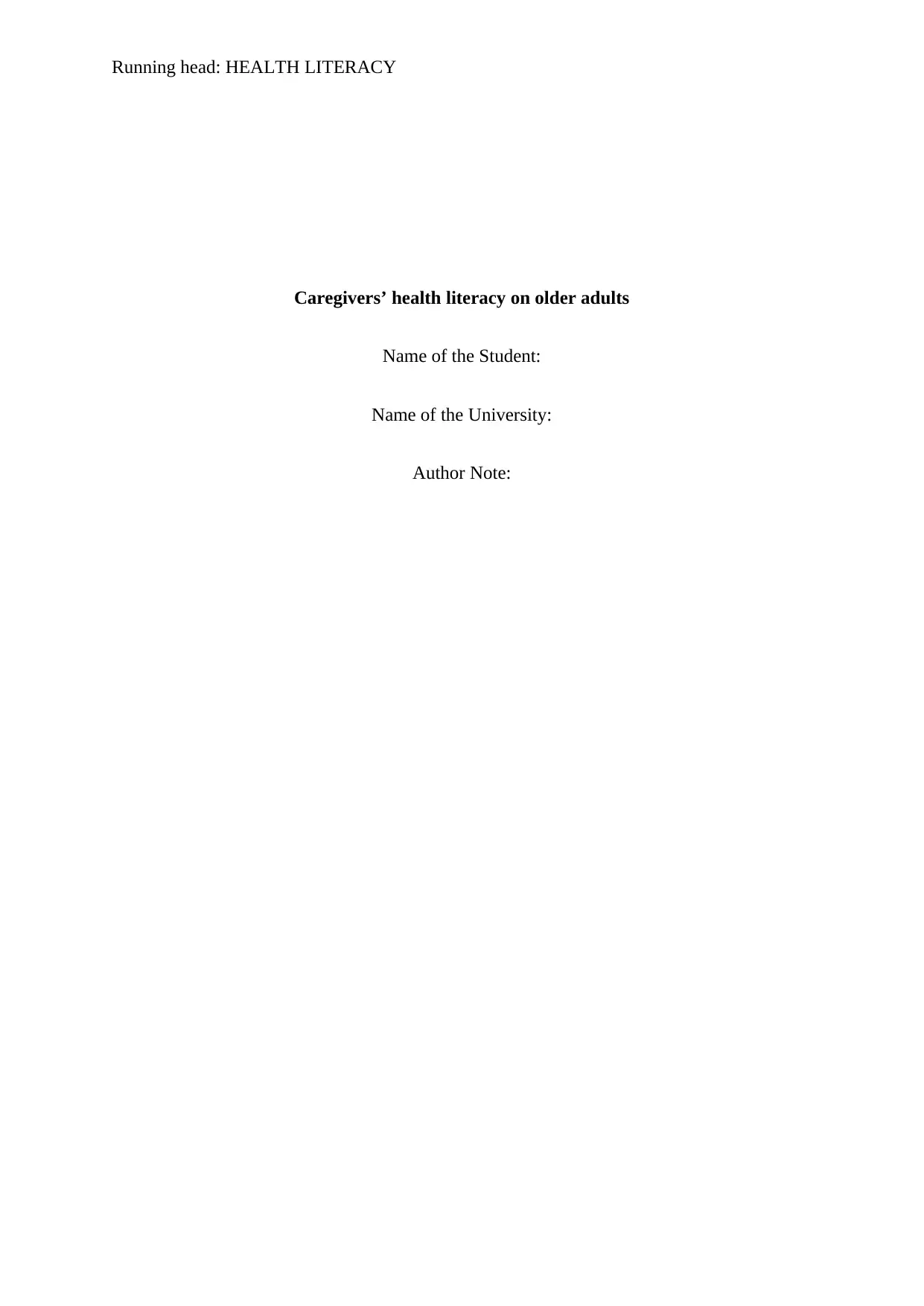
Running head: HEALTH LITERACY
Caregivers’ health literacy on older adults
Name of the Student:
Name of the University:
Author Note:
Caregivers’ health literacy on older adults
Name of the Student:
Name of the University:
Author Note:
Paraphrase This Document
Need a fresh take? Get an instant paraphrase of this document with our AI Paraphraser
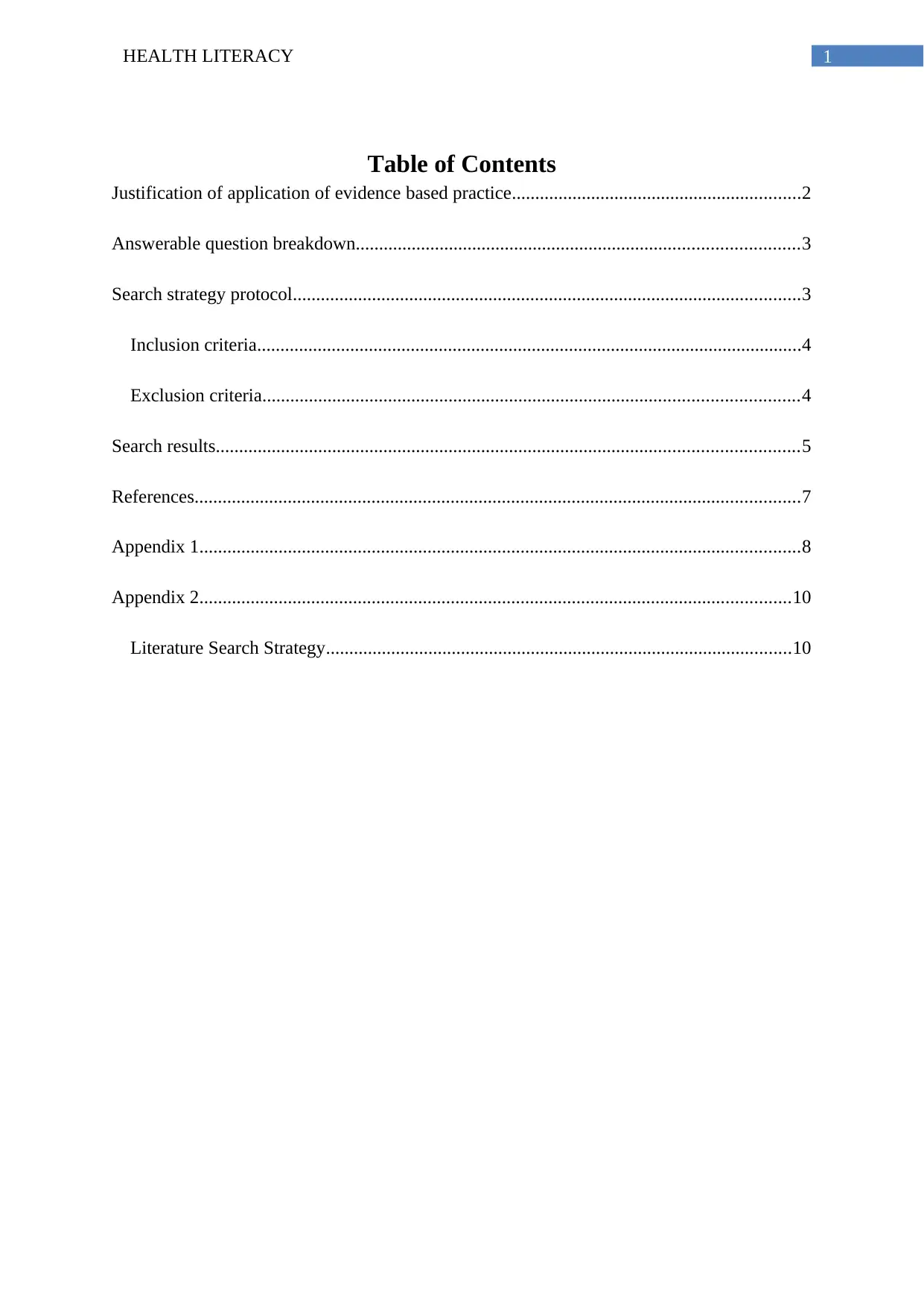
1HEALTH LITERACY
Table of Contents
Justification of application of evidence based practice..............................................................2
Answerable question breakdown...............................................................................................3
Search strategy protocol.............................................................................................................3
Inclusion criteria.....................................................................................................................4
Exclusion criteria...................................................................................................................4
Search results.............................................................................................................................5
References..................................................................................................................................7
Appendix 1.................................................................................................................................8
Appendix 2...............................................................................................................................10
Literature Search Strategy....................................................................................................10
Table of Contents
Justification of application of evidence based practice..............................................................2
Answerable question breakdown...............................................................................................3
Search strategy protocol.............................................................................................................3
Inclusion criteria.....................................................................................................................4
Exclusion criteria...................................................................................................................4
Search results.............................................................................................................................5
References..................................................................................................................................7
Appendix 1.................................................................................................................................8
Appendix 2...............................................................................................................................10
Literature Search Strategy....................................................................................................10
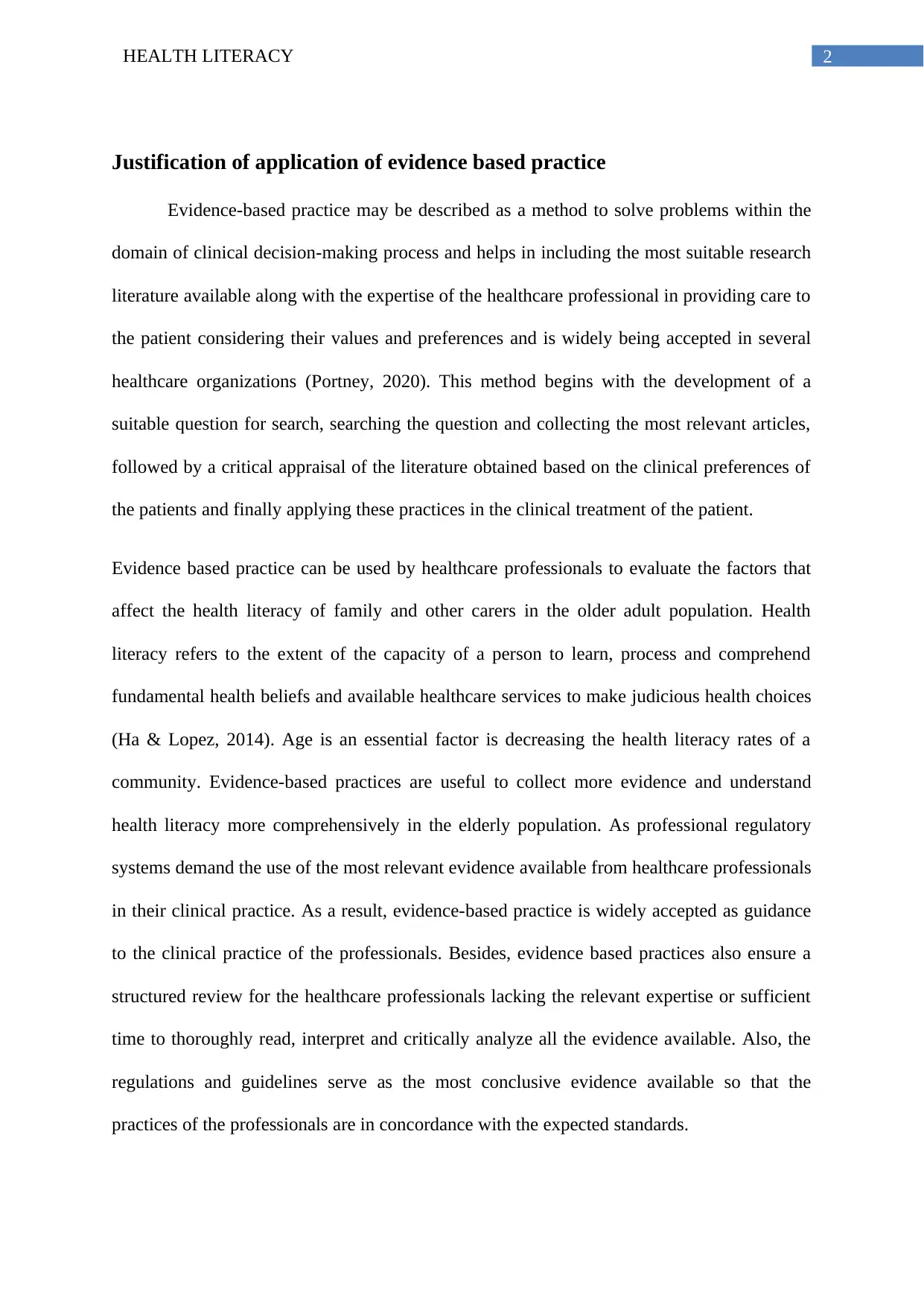
2HEALTH LITERACY
Justification of application of evidence based practice
Evidence-based practice may be described as a method to solve problems within the
domain of clinical decision-making process and helps in including the most suitable research
literature available along with the expertise of the healthcare professional in providing care to
the patient considering their values and preferences and is widely being accepted in several
healthcare organizations (Portney, 2020). This method begins with the development of a
suitable question for search, searching the question and collecting the most relevant articles,
followed by a critical appraisal of the literature obtained based on the clinical preferences of
the patients and finally applying these practices in the clinical treatment of the patient.
Evidence based practice can be used by healthcare professionals to evaluate the factors that
affect the health literacy of family and other carers in the older adult population. Health
literacy refers to the extent of the capacity of a person to learn, process and comprehend
fundamental health beliefs and available healthcare services to make judicious health choices
(Ha & Lopez, 2014). Age is an essential factor is decreasing the health literacy rates of a
community. Evidence-based practices are useful to collect more evidence and understand
health literacy more comprehensively in the elderly population. As professional regulatory
systems demand the use of the most relevant evidence available from healthcare professionals
in their clinical practice. As a result, evidence-based practice is widely accepted as guidance
to the clinical practice of the professionals. Besides, evidence based practices also ensure a
structured review for the healthcare professionals lacking the relevant expertise or sufficient
time to thoroughly read, interpret and critically analyze all the evidence available. Also, the
regulations and guidelines serve as the most conclusive evidence available so that the
practices of the professionals are in concordance with the expected standards.
Justification of application of evidence based practice
Evidence-based practice may be described as a method to solve problems within the
domain of clinical decision-making process and helps in including the most suitable research
literature available along with the expertise of the healthcare professional in providing care to
the patient considering their values and preferences and is widely being accepted in several
healthcare organizations (Portney, 2020). This method begins with the development of a
suitable question for search, searching the question and collecting the most relevant articles,
followed by a critical appraisal of the literature obtained based on the clinical preferences of
the patients and finally applying these practices in the clinical treatment of the patient.
Evidence based practice can be used by healthcare professionals to evaluate the factors that
affect the health literacy of family and other carers in the older adult population. Health
literacy refers to the extent of the capacity of a person to learn, process and comprehend
fundamental health beliefs and available healthcare services to make judicious health choices
(Ha & Lopez, 2014). Age is an essential factor is decreasing the health literacy rates of a
community. Evidence-based practices are useful to collect more evidence and understand
health literacy more comprehensively in the elderly population. As professional regulatory
systems demand the use of the most relevant evidence available from healthcare professionals
in their clinical practice. As a result, evidence-based practice is widely accepted as guidance
to the clinical practice of the professionals. Besides, evidence based practices also ensure a
structured review for the healthcare professionals lacking the relevant expertise or sufficient
time to thoroughly read, interpret and critically analyze all the evidence available. Also, the
regulations and guidelines serve as the most conclusive evidence available so that the
practices of the professionals are in concordance with the expected standards.
⊘ This is a preview!⊘
Do you want full access?
Subscribe today to unlock all pages.

Trusted by 1+ million students worldwide
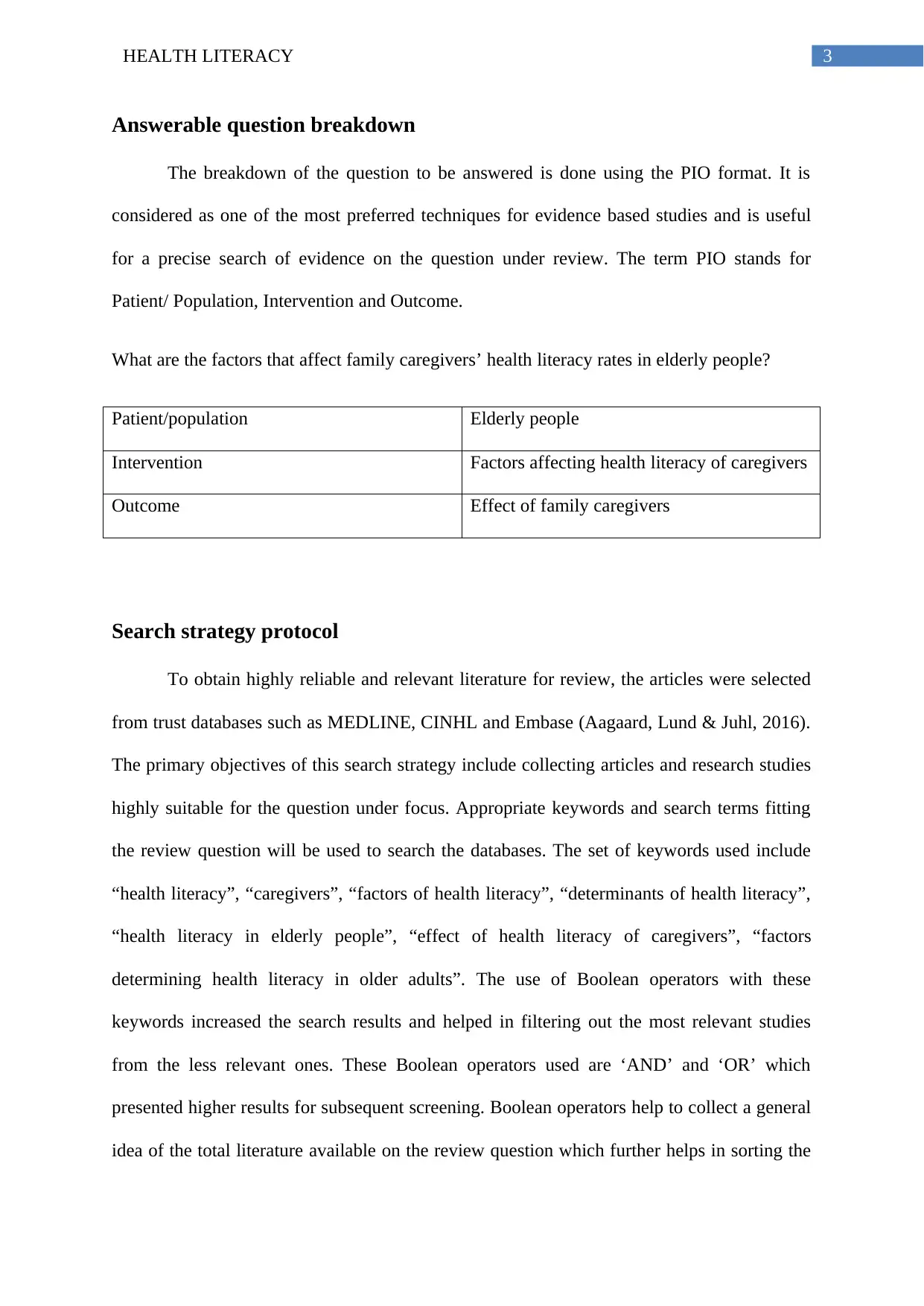
3HEALTH LITERACY
Answerable question breakdown
The breakdown of the question to be answered is done using the PIO format. It is
considered as one of the most preferred techniques for evidence based studies and is useful
for a precise search of evidence on the question under review. The term PIO stands for
Patient/ Population, Intervention and Outcome.
What are the factors that affect family caregivers’ health literacy rates in elderly people?
Patient/population Elderly people
Intervention Factors affecting health literacy of caregivers
Outcome Effect of family caregivers
Search strategy protocol
To obtain highly reliable and relevant literature for review, the articles were selected
from trust databases such as MEDLINE, CINHL and Embase (Aagaard, Lund & Juhl, 2016).
The primary objectives of this search strategy include collecting articles and research studies
highly suitable for the question under focus. Appropriate keywords and search terms fitting
the review question will be used to search the databases. The set of keywords used include
“health literacy”, “caregivers”, “factors of health literacy”, “determinants of health literacy”,
“health literacy in elderly people”, “effect of health literacy of caregivers”, “factors
determining health literacy in older adults”. The use of Boolean operators with these
keywords increased the search results and helped in filtering out the most relevant studies
from the less relevant ones. These Boolean operators used are ‘AND’ and ‘OR’ which
presented higher results for subsequent screening. Boolean operators help to collect a general
idea of the total literature available on the review question which further helps in sorting the
Answerable question breakdown
The breakdown of the question to be answered is done using the PIO format. It is
considered as one of the most preferred techniques for evidence based studies and is useful
for a precise search of evidence on the question under review. The term PIO stands for
Patient/ Population, Intervention and Outcome.
What are the factors that affect family caregivers’ health literacy rates in elderly people?
Patient/population Elderly people
Intervention Factors affecting health literacy of caregivers
Outcome Effect of family caregivers
Search strategy protocol
To obtain highly reliable and relevant literature for review, the articles were selected
from trust databases such as MEDLINE, CINHL and Embase (Aagaard, Lund & Juhl, 2016).
The primary objectives of this search strategy include collecting articles and research studies
highly suitable for the question under focus. Appropriate keywords and search terms fitting
the review question will be used to search the databases. The set of keywords used include
“health literacy”, “caregivers”, “factors of health literacy”, “determinants of health literacy”,
“health literacy in elderly people”, “effect of health literacy of caregivers”, “factors
determining health literacy in older adults”. The use of Boolean operators with these
keywords increased the search results and helped in filtering out the most relevant studies
from the less relevant ones. These Boolean operators used are ‘AND’ and ‘OR’ which
presented higher results for subsequent screening. Boolean operators help to collect a general
idea of the total literature available on the review question which further helps in sorting the
Paraphrase This Document
Need a fresh take? Get an instant paraphrase of this document with our AI Paraphraser
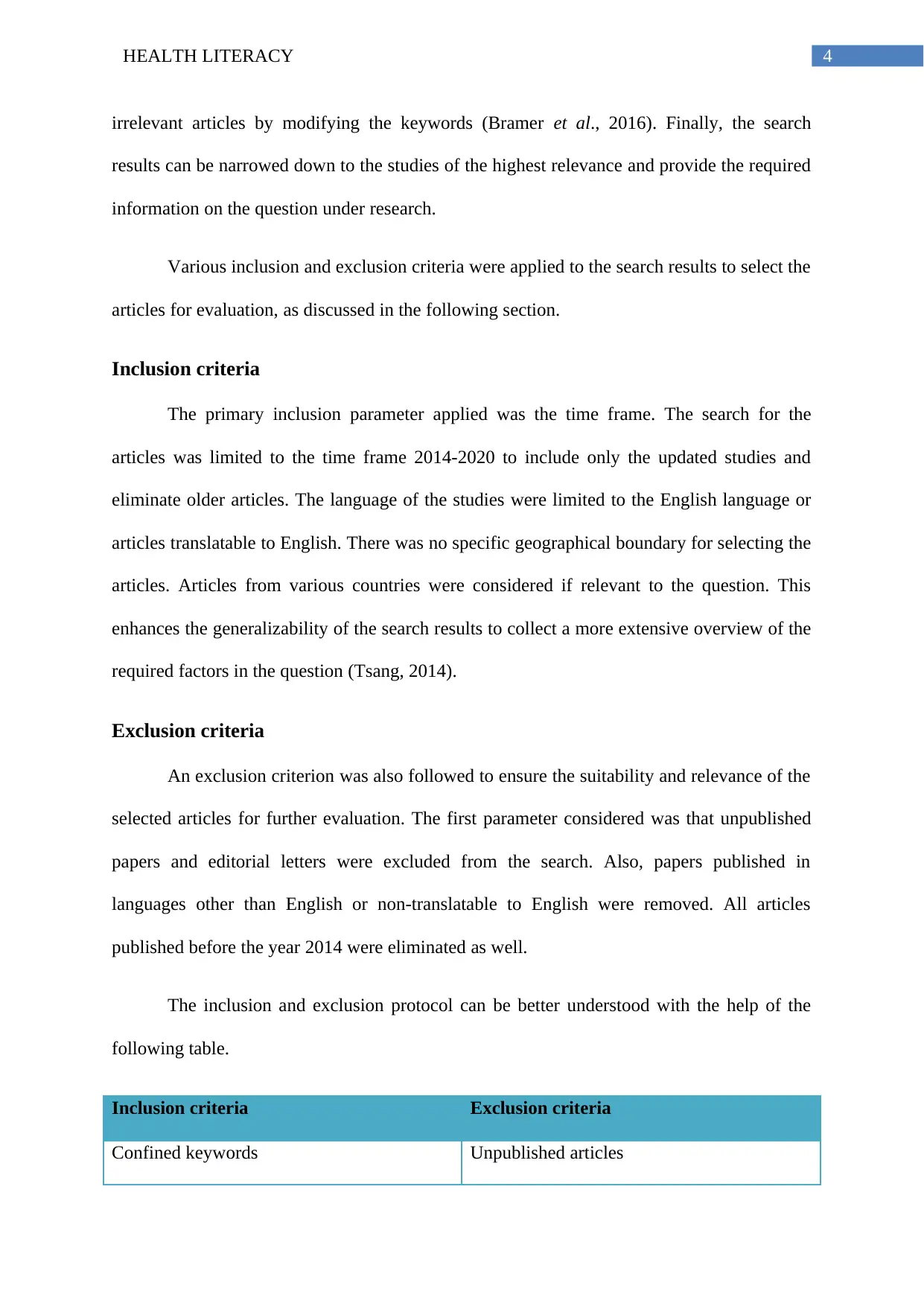
4HEALTH LITERACY
irrelevant articles by modifying the keywords (Bramer et al., 2016). Finally, the search
results can be narrowed down to the studies of the highest relevance and provide the required
information on the question under research.
Various inclusion and exclusion criteria were applied to the search results to select the
articles for evaluation, as discussed in the following section.
Inclusion criteria
The primary inclusion parameter applied was the time frame. The search for the
articles was limited to the time frame 2014-2020 to include only the updated studies and
eliminate older articles. The language of the studies were limited to the English language or
articles translatable to English. There was no specific geographical boundary for selecting the
articles. Articles from various countries were considered if relevant to the question. This
enhances the generalizability of the search results to collect a more extensive overview of the
required factors in the question (Tsang, 2014).
Exclusion criteria
An exclusion criterion was also followed to ensure the suitability and relevance of the
selected articles for further evaluation. The first parameter considered was that unpublished
papers and editorial letters were excluded from the search. Also, papers published in
languages other than English or non-translatable to English were removed. All articles
published before the year 2014 were eliminated as well.
The inclusion and exclusion protocol can be better understood with the help of the
following table.
Inclusion criteria Exclusion criteria
Confined keywords Unpublished articles
irrelevant articles by modifying the keywords (Bramer et al., 2016). Finally, the search
results can be narrowed down to the studies of the highest relevance and provide the required
information on the question under research.
Various inclusion and exclusion criteria were applied to the search results to select the
articles for evaluation, as discussed in the following section.
Inclusion criteria
The primary inclusion parameter applied was the time frame. The search for the
articles was limited to the time frame 2014-2020 to include only the updated studies and
eliminate older articles. The language of the studies were limited to the English language or
articles translatable to English. There was no specific geographical boundary for selecting the
articles. Articles from various countries were considered if relevant to the question. This
enhances the generalizability of the search results to collect a more extensive overview of the
required factors in the question (Tsang, 2014).
Exclusion criteria
An exclusion criterion was also followed to ensure the suitability and relevance of the
selected articles for further evaluation. The first parameter considered was that unpublished
papers and editorial letters were excluded from the search. Also, papers published in
languages other than English or non-translatable to English were removed. All articles
published before the year 2014 were eliminated as well.
The inclusion and exclusion protocol can be better understood with the help of the
following table.
Inclusion criteria Exclusion criteria
Confined keywords Unpublished articles
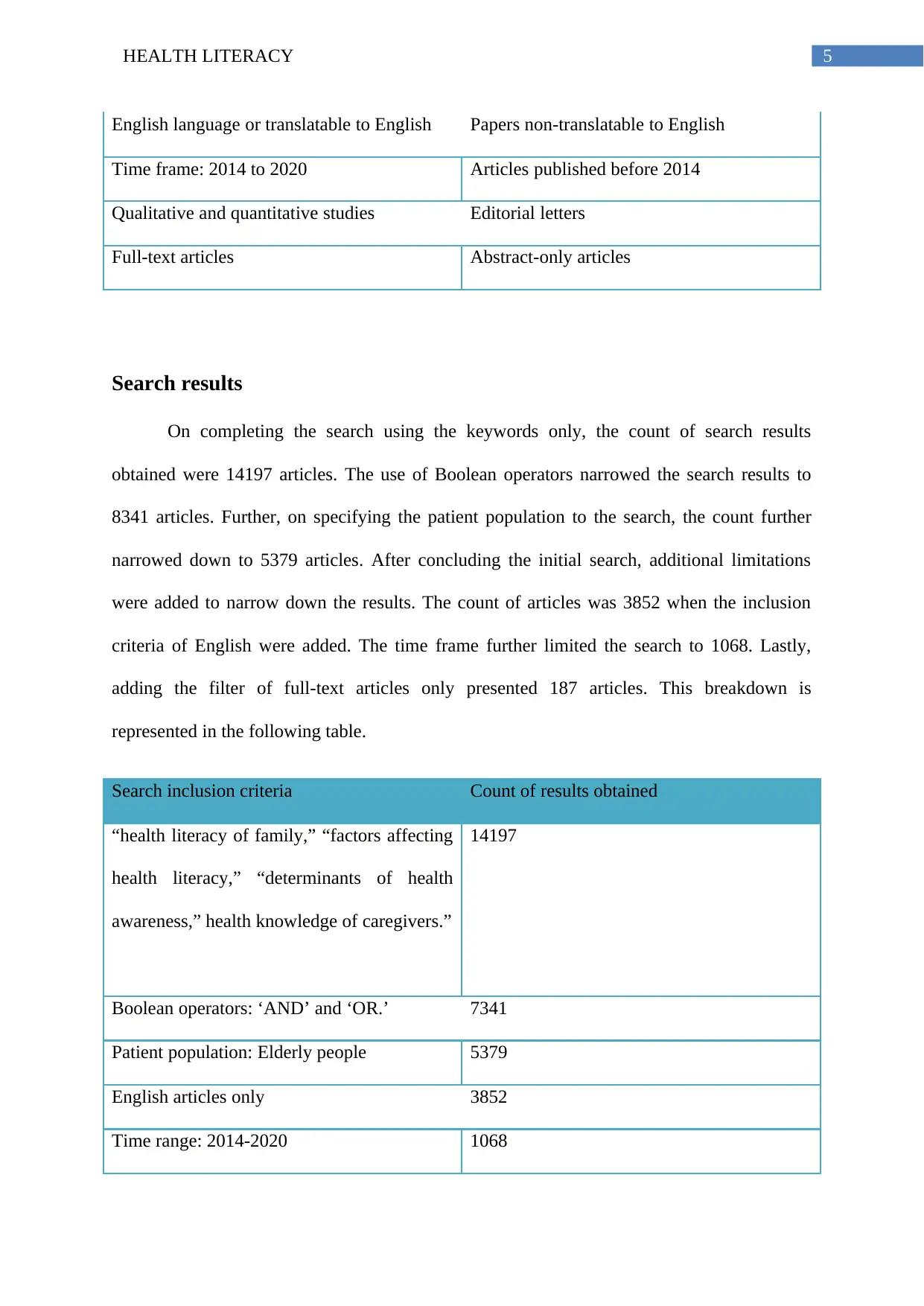
5HEALTH LITERACY
English language or translatable to English Papers non-translatable to English
Time frame: 2014 to 2020 Articles published before 2014
Qualitative and quantitative studies Editorial letters
Full-text articles Abstract-only articles
Search results
On completing the search using the keywords only, the count of search results
obtained were 14197 articles. The use of Boolean operators narrowed the search results to
8341 articles. Further, on specifying the patient population to the search, the count further
narrowed down to 5379 articles. After concluding the initial search, additional limitations
were added to narrow down the results. The count of articles was 3852 when the inclusion
criteria of English were added. The time frame further limited the search to 1068. Lastly,
adding the filter of full-text articles only presented 187 articles. This breakdown is
represented in the following table.
Search inclusion criteria Count of results obtained
“health literacy of family,” “factors affecting
health literacy,” “determinants of health
awareness,” health knowledge of caregivers.”
14197
Boolean operators: ‘AND’ and ‘OR.’ 7341
Patient population: Elderly people 5379
English articles only 3852
Time range: 2014-2020 1068
English language or translatable to English Papers non-translatable to English
Time frame: 2014 to 2020 Articles published before 2014
Qualitative and quantitative studies Editorial letters
Full-text articles Abstract-only articles
Search results
On completing the search using the keywords only, the count of search results
obtained were 14197 articles. The use of Boolean operators narrowed the search results to
8341 articles. Further, on specifying the patient population to the search, the count further
narrowed down to 5379 articles. After concluding the initial search, additional limitations
were added to narrow down the results. The count of articles was 3852 when the inclusion
criteria of English were added. The time frame further limited the search to 1068. Lastly,
adding the filter of full-text articles only presented 187 articles. This breakdown is
represented in the following table.
Search inclusion criteria Count of results obtained
“health literacy of family,” “factors affecting
health literacy,” “determinants of health
awareness,” health knowledge of caregivers.”
14197
Boolean operators: ‘AND’ and ‘OR.’ 7341
Patient population: Elderly people 5379
English articles only 3852
Time range: 2014-2020 1068
⊘ This is a preview!⊘
Do you want full access?
Subscribe today to unlock all pages.

Trusted by 1+ million students worldwide
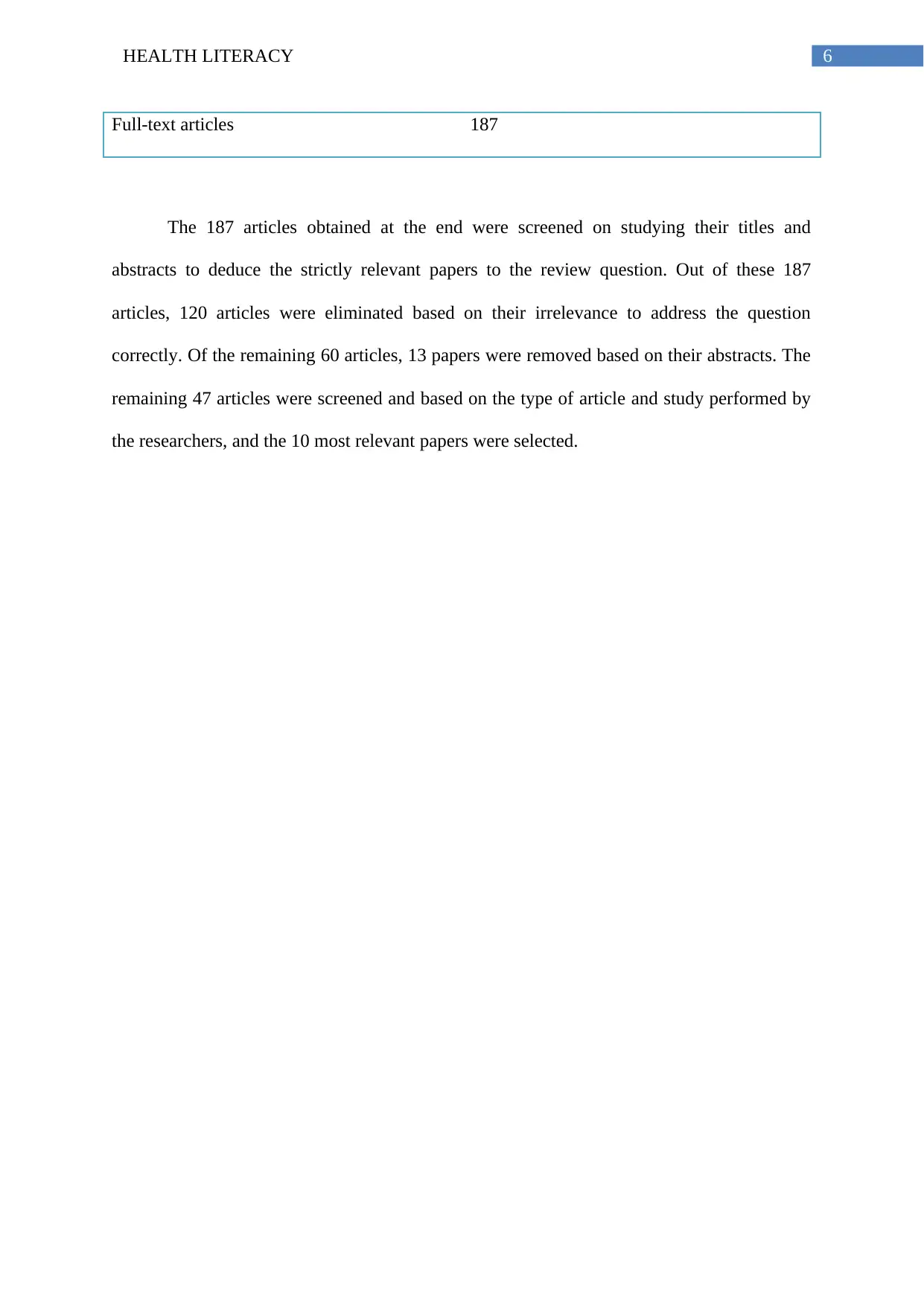
6HEALTH LITERACY
Full-text articles 187
The 187 articles obtained at the end were screened on studying their titles and
abstracts to deduce the strictly relevant papers to the review question. Out of these 187
articles, 120 articles were eliminated based on their irrelevance to address the question
correctly. Of the remaining 60 articles, 13 papers were removed based on their abstracts. The
remaining 47 articles were screened and based on the type of article and study performed by
the researchers, and the 10 most relevant papers were selected.
Full-text articles 187
The 187 articles obtained at the end were screened on studying their titles and
abstracts to deduce the strictly relevant papers to the review question. Out of these 187
articles, 120 articles were eliminated based on their irrelevance to address the question
correctly. Of the remaining 60 articles, 13 papers were removed based on their abstracts. The
remaining 47 articles were screened and based on the type of article and study performed by
the researchers, and the 10 most relevant papers were selected.
Paraphrase This Document
Need a fresh take? Get an instant paraphrase of this document with our AI Paraphraser
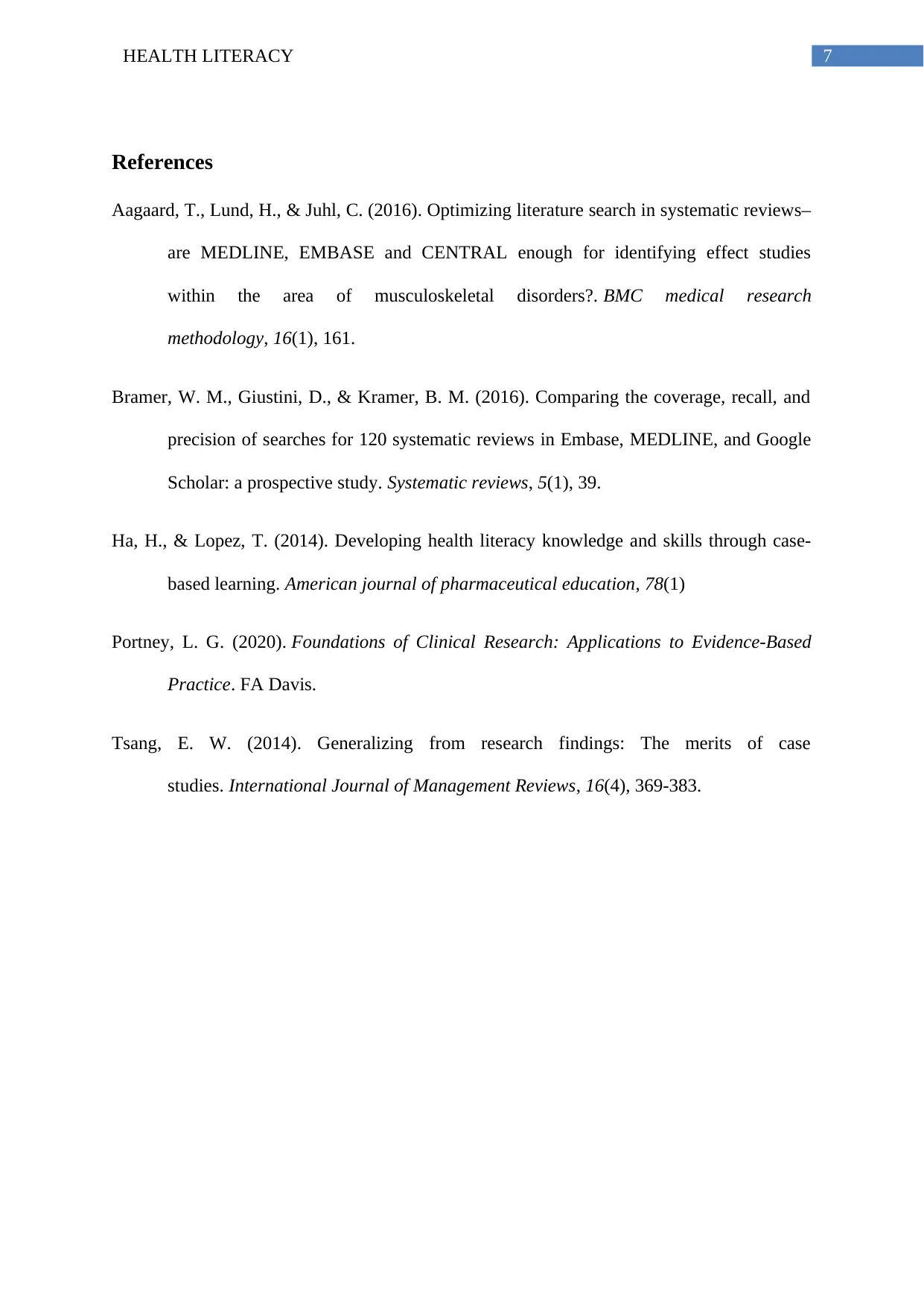
7HEALTH LITERACY
References
Aagaard, T., Lund, H., & Juhl, C. (2016). Optimizing literature search in systematic reviews–
are MEDLINE, EMBASE and CENTRAL enough for identifying effect studies
within the area of musculoskeletal disorders?. BMC medical research
methodology, 16(1), 161.
Bramer, W. M., Giustini, D., & Kramer, B. M. (2016). Comparing the coverage, recall, and
precision of searches for 120 systematic reviews in Embase, MEDLINE, and Google
Scholar: a prospective study. Systematic reviews, 5(1), 39.
Ha, H., & Lopez, T. (2014). Developing health literacy knowledge and skills through case-
based learning. American journal of pharmaceutical education, 78(1)
Portney, L. G. (2020). Foundations of Clinical Research: Applications to Evidence-Based
Practice. FA Davis.
Tsang, E. W. (2014). Generalizing from research findings: The merits of case
studies. International Journal of Management Reviews, 16(4), 369-383.
References
Aagaard, T., Lund, H., & Juhl, C. (2016). Optimizing literature search in systematic reviews–
are MEDLINE, EMBASE and CENTRAL enough for identifying effect studies
within the area of musculoskeletal disorders?. BMC medical research
methodology, 16(1), 161.
Bramer, W. M., Giustini, D., & Kramer, B. M. (2016). Comparing the coverage, recall, and
precision of searches for 120 systematic reviews in Embase, MEDLINE, and Google
Scholar: a prospective study. Systematic reviews, 5(1), 39.
Ha, H., & Lopez, T. (2014). Developing health literacy knowledge and skills through case-
based learning. American journal of pharmaceutical education, 78(1)
Portney, L. G. (2020). Foundations of Clinical Research: Applications to Evidence-Based
Practice. FA Davis.
Tsang, E. W. (2014). Generalizing from research findings: The merits of case
studies. International Journal of Management Reviews, 16(4), 369-383.
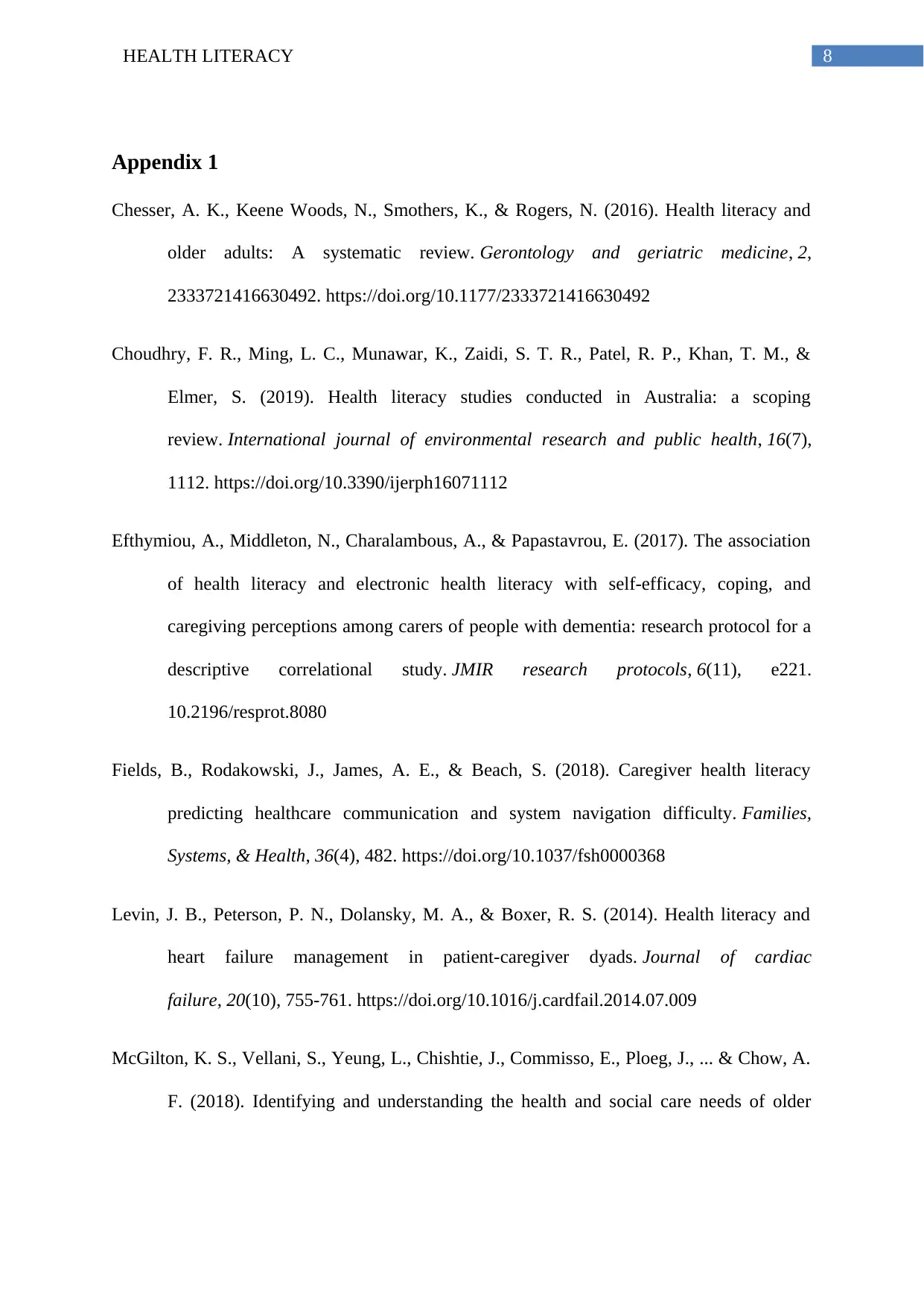
8HEALTH LITERACY
Appendix 1
Chesser, A. K., Keene Woods, N., Smothers, K., & Rogers, N. (2016). Health literacy and
older adults: A systematic review. Gerontology and geriatric medicine, 2,
2333721416630492. https://doi.org/10.1177/2333721416630492
Choudhry, F. R., Ming, L. C., Munawar, K., Zaidi, S. T. R., Patel, R. P., Khan, T. M., &
Elmer, S. (2019). Health literacy studies conducted in Australia: a scoping
review. International journal of environmental research and public health, 16(7),
1112. https://doi.org/10.3390/ijerph16071112
Efthymiou, A., Middleton, N., Charalambous, A., & Papastavrou, E. (2017). The association
of health literacy and electronic health literacy with self-efficacy, coping, and
caregiving perceptions among carers of people with dementia: research protocol for a
descriptive correlational study. JMIR research protocols, 6(11), e221.
10.2196/resprot.8080
Fields, B., Rodakowski, J., James, A. E., & Beach, S. (2018). Caregiver health literacy
predicting healthcare communication and system navigation difficulty. Families,
Systems, & Health, 36(4), 482. https://doi.org/10.1037/fsh0000368
Levin, J. B., Peterson, P. N., Dolansky, M. A., & Boxer, R. S. (2014). Health literacy and
heart failure management in patient-caregiver dyads. Journal of cardiac
failure, 20(10), 755-761. https://doi.org/10.1016/j.cardfail.2014.07.009
McGilton, K. S., Vellani, S., Yeung, L., Chishtie, J., Commisso, E., Ploeg, J., ... & Chow, A.
F. (2018). Identifying and understanding the health and social care needs of older
Appendix 1
Chesser, A. K., Keene Woods, N., Smothers, K., & Rogers, N. (2016). Health literacy and
older adults: A systematic review. Gerontology and geriatric medicine, 2,
2333721416630492. https://doi.org/10.1177/2333721416630492
Choudhry, F. R., Ming, L. C., Munawar, K., Zaidi, S. T. R., Patel, R. P., Khan, T. M., &
Elmer, S. (2019). Health literacy studies conducted in Australia: a scoping
review. International journal of environmental research and public health, 16(7),
1112. https://doi.org/10.3390/ijerph16071112
Efthymiou, A., Middleton, N., Charalambous, A., & Papastavrou, E. (2017). The association
of health literacy and electronic health literacy with self-efficacy, coping, and
caregiving perceptions among carers of people with dementia: research protocol for a
descriptive correlational study. JMIR research protocols, 6(11), e221.
10.2196/resprot.8080
Fields, B., Rodakowski, J., James, A. E., & Beach, S. (2018). Caregiver health literacy
predicting healthcare communication and system navigation difficulty. Families,
Systems, & Health, 36(4), 482. https://doi.org/10.1037/fsh0000368
Levin, J. B., Peterson, P. N., Dolansky, M. A., & Boxer, R. S. (2014). Health literacy and
heart failure management in patient-caregiver dyads. Journal of cardiac
failure, 20(10), 755-761. https://doi.org/10.1016/j.cardfail.2014.07.009
McGilton, K. S., Vellani, S., Yeung, L., Chishtie, J., Commisso, E., Ploeg, J., ... & Chow, A.
F. (2018). Identifying and understanding the health and social care needs of older
⊘ This is a preview!⊘
Do you want full access?
Subscribe today to unlock all pages.

Trusted by 1+ million students worldwide
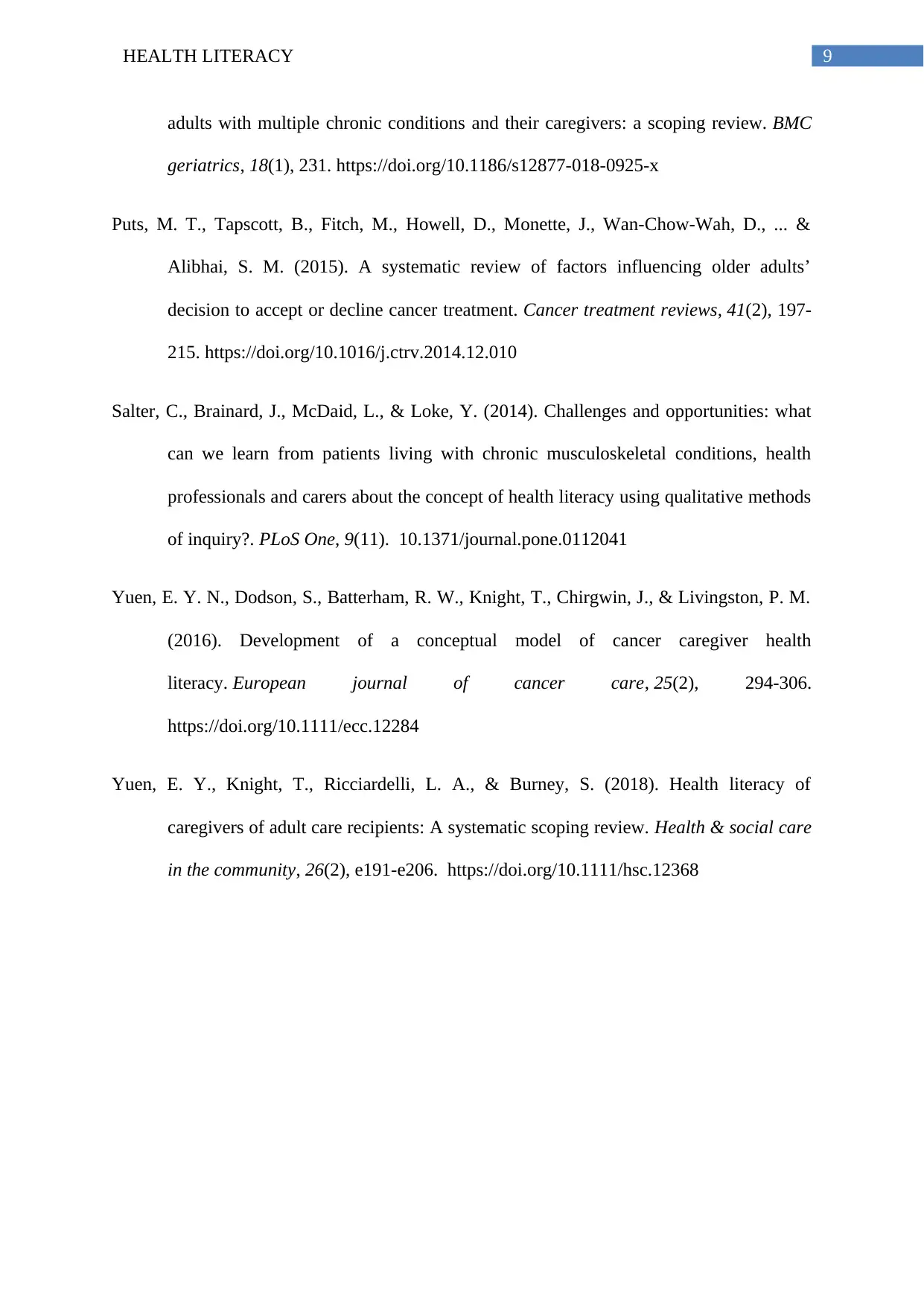
9HEALTH LITERACY
adults with multiple chronic conditions and their caregivers: a scoping review. BMC
geriatrics, 18(1), 231. https://doi.org/10.1186/s12877-018-0925-x
Puts, M. T., Tapscott, B., Fitch, M., Howell, D., Monette, J., Wan-Chow-Wah, D., ... &
Alibhai, S. M. (2015). A systematic review of factors influencing older adults’
decision to accept or decline cancer treatment. Cancer treatment reviews, 41(2), 197-
215. https://doi.org/10.1016/j.ctrv.2014.12.010
Salter, C., Brainard, J., McDaid, L., & Loke, Y. (2014). Challenges and opportunities: what
can we learn from patients living with chronic musculoskeletal conditions, health
professionals and carers about the concept of health literacy using qualitative methods
of inquiry?. PLoS One, 9(11). 10.1371/journal.pone.0112041
Yuen, E. Y. N., Dodson, S., Batterham, R. W., Knight, T., Chirgwin, J., & Livingston, P. M.
(2016). Development of a conceptual model of cancer caregiver health
literacy. European journal of cancer care, 25(2), 294-306.
https://doi.org/10.1111/ecc.12284
Yuen, E. Y., Knight, T., Ricciardelli, L. A., & Burney, S. (2018). Health literacy of
caregivers of adult care recipients: A systematic scoping review. Health & social care
in the community, 26(2), e191-e206. https://doi.org/10.1111/hsc.12368
adults with multiple chronic conditions and their caregivers: a scoping review. BMC
geriatrics, 18(1), 231. https://doi.org/10.1186/s12877-018-0925-x
Puts, M. T., Tapscott, B., Fitch, M., Howell, D., Monette, J., Wan-Chow-Wah, D., ... &
Alibhai, S. M. (2015). A systematic review of factors influencing older adults’
decision to accept or decline cancer treatment. Cancer treatment reviews, 41(2), 197-
215. https://doi.org/10.1016/j.ctrv.2014.12.010
Salter, C., Brainard, J., McDaid, L., & Loke, Y. (2014). Challenges and opportunities: what
can we learn from patients living with chronic musculoskeletal conditions, health
professionals and carers about the concept of health literacy using qualitative methods
of inquiry?. PLoS One, 9(11). 10.1371/journal.pone.0112041
Yuen, E. Y. N., Dodson, S., Batterham, R. W., Knight, T., Chirgwin, J., & Livingston, P. M.
(2016). Development of a conceptual model of cancer caregiver health
literacy. European journal of cancer care, 25(2), 294-306.
https://doi.org/10.1111/ecc.12284
Yuen, E. Y., Knight, T., Ricciardelli, L. A., & Burney, S. (2018). Health literacy of
caregivers of adult care recipients: A systematic scoping review. Health & social care
in the community, 26(2), e191-e206. https://doi.org/10.1111/hsc.12368
Paraphrase This Document
Need a fresh take? Get an instant paraphrase of this document with our AI Paraphraser
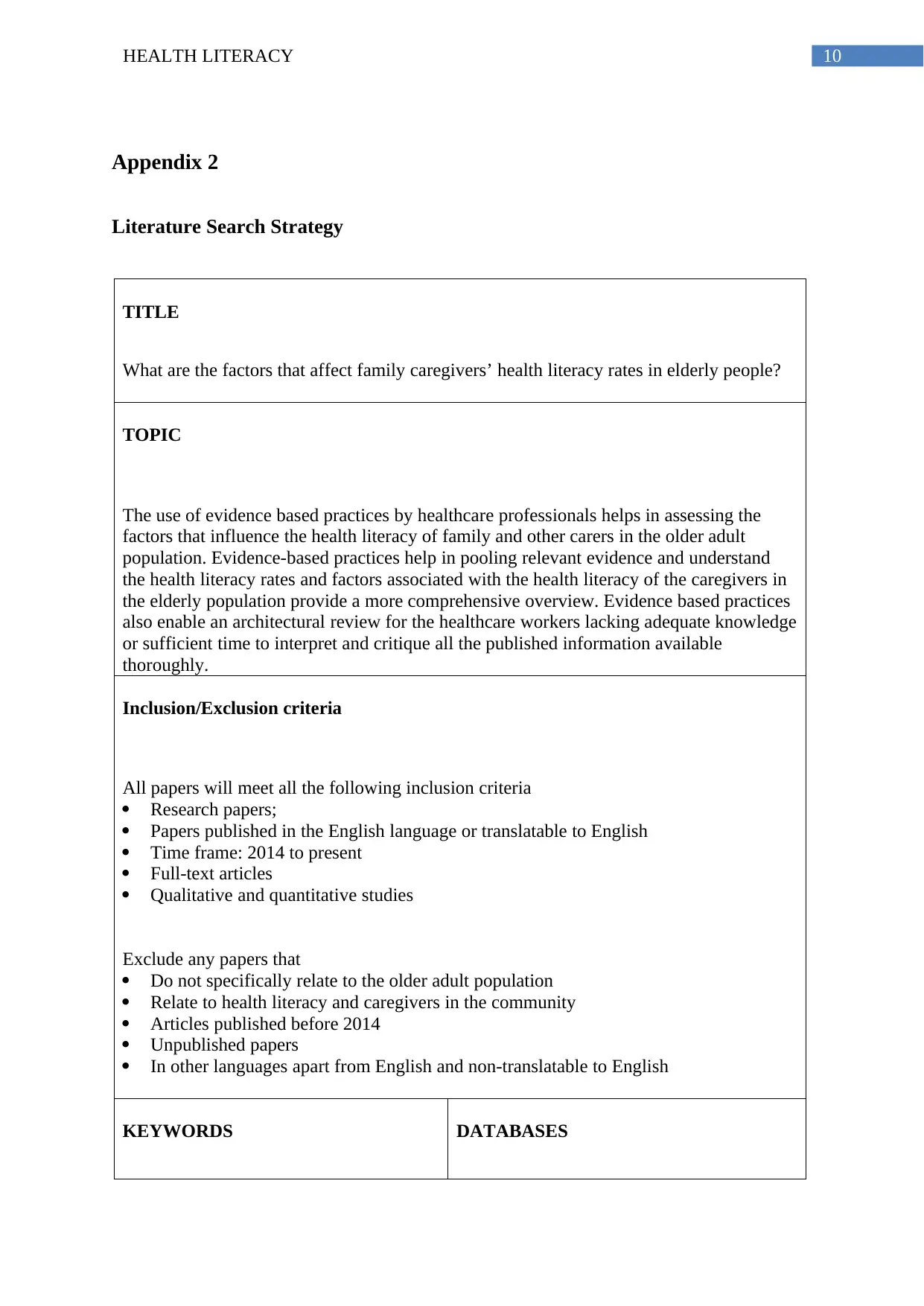
10HEALTH LITERACY
Appendix 2
Literature Search Strategy
TITLE
What are the factors that affect family caregivers’ health literacy rates in elderly people?
TOPIC
The use of evidence based practices by healthcare professionals helps in assessing the
factors that influence the health literacy of family and other carers in the older adult
population. Evidence-based practices help in pooling relevant evidence and understand
the health literacy rates and factors associated with the health literacy of the caregivers in
the elderly population provide a more comprehensive overview. Evidence based practices
also enable an architectural review for the healthcare workers lacking adequate knowledge
or sufficient time to interpret and critique all the published information available
thoroughly.
Inclusion/Exclusion criteria
All papers will meet all the following inclusion criteria
Research papers;
Papers published in the English language or translatable to English
Time frame: 2014 to present
Full-text articles
Qualitative and quantitative studies
Exclude any papers that
Do not specifically relate to the older adult population
Relate to health literacy and caregivers in the community
Articles published before 2014
Unpublished papers
In other languages apart from English and non-translatable to English
KEYWORDS DATABASES
Appendix 2
Literature Search Strategy
TITLE
What are the factors that affect family caregivers’ health literacy rates in elderly people?
TOPIC
The use of evidence based practices by healthcare professionals helps in assessing the
factors that influence the health literacy of family and other carers in the older adult
population. Evidence-based practices help in pooling relevant evidence and understand
the health literacy rates and factors associated with the health literacy of the caregivers in
the elderly population provide a more comprehensive overview. Evidence based practices
also enable an architectural review for the healthcare workers lacking adequate knowledge
or sufficient time to interpret and critique all the published information available
thoroughly.
Inclusion/Exclusion criteria
All papers will meet all the following inclusion criteria
Research papers;
Papers published in the English language or translatable to English
Time frame: 2014 to present
Full-text articles
Qualitative and quantitative studies
Exclude any papers that
Do not specifically relate to the older adult population
Relate to health literacy and caregivers in the community
Articles published before 2014
Unpublished papers
In other languages apart from English and non-translatable to English
KEYWORDS DATABASES
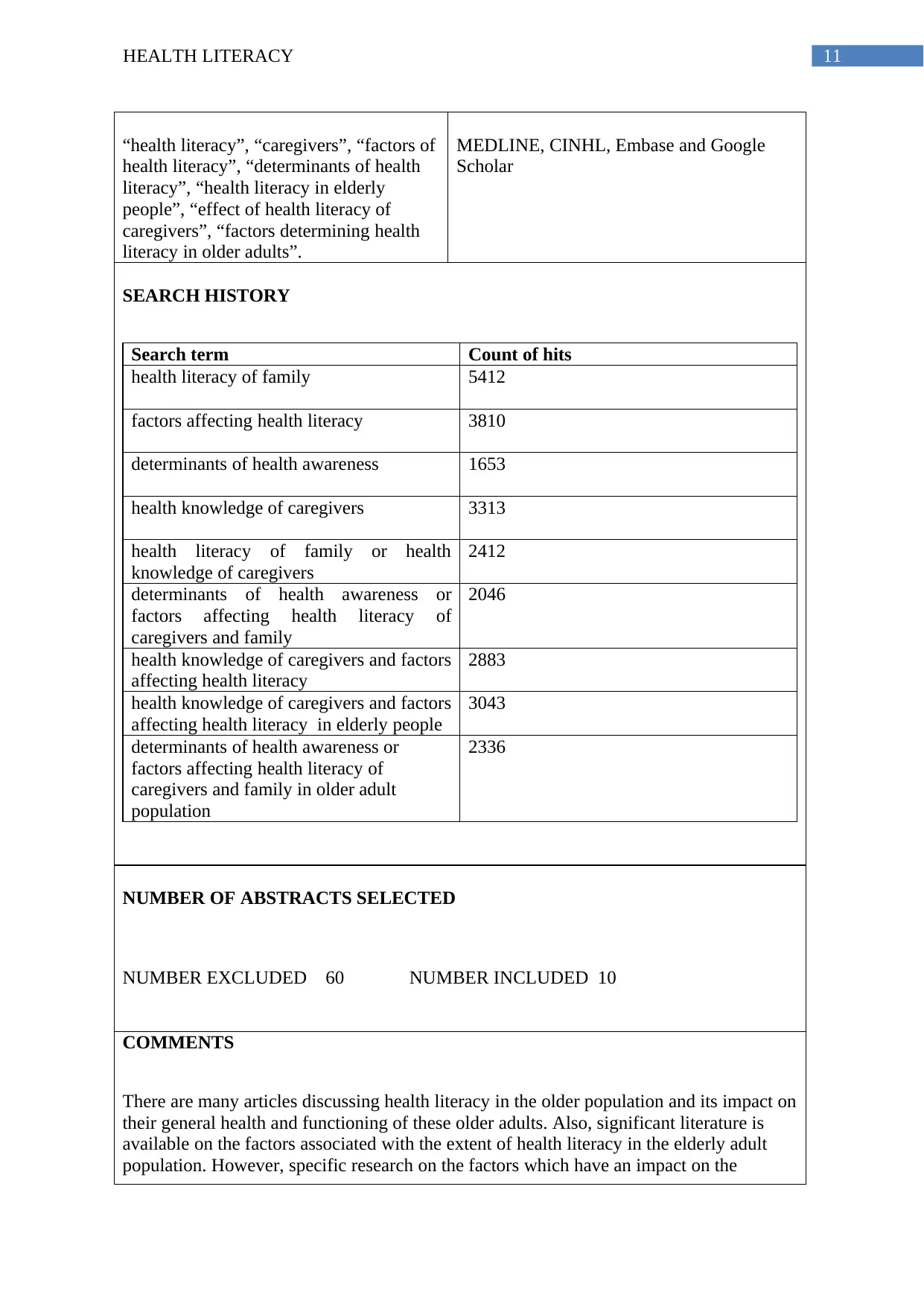
11HEALTH LITERACY
“health literacy”, “caregivers”, “factors of
health literacy”, “determinants of health
literacy”, “health literacy in elderly
people”, “effect of health literacy of
caregivers”, “factors determining health
literacy in older adults”.
MEDLINE, CINHL, Embase and Google
Scholar
SEARCH HISTORY
Search term Count of hits
health literacy of family 5412
factors affecting health literacy 3810
determinants of health awareness 1653
health knowledge of caregivers 3313
health literacy of family or health
knowledge of caregivers
2412
determinants of health awareness or
factors affecting health literacy of
caregivers and family
2046
health knowledge of caregivers and factors
affecting health literacy
2883
health knowledge of caregivers and factors
affecting health literacy in elderly people
3043
determinants of health awareness or
factors affecting health literacy of
caregivers and family in older adult
population
2336
NUMBER OF ABSTRACTS SELECTED
NUMBER EXCLUDED 60 NUMBER INCLUDED 10
COMMENTS
There are many articles discussing health literacy in the older population and its impact on
their general health and functioning of these older adults. Also, significant literature is
available on the factors associated with the extent of health literacy in the elderly adult
population. However, specific research on the factors which have an impact on the
“health literacy”, “caregivers”, “factors of
health literacy”, “determinants of health
literacy”, “health literacy in elderly
people”, “effect of health literacy of
caregivers”, “factors determining health
literacy in older adults”.
MEDLINE, CINHL, Embase and Google
Scholar
SEARCH HISTORY
Search term Count of hits
health literacy of family 5412
factors affecting health literacy 3810
determinants of health awareness 1653
health knowledge of caregivers 3313
health literacy of family or health
knowledge of caregivers
2412
determinants of health awareness or
factors affecting health literacy of
caregivers and family
2046
health knowledge of caregivers and factors
affecting health literacy
2883
health knowledge of caregivers and factors
affecting health literacy in elderly people
3043
determinants of health awareness or
factors affecting health literacy of
caregivers and family in older adult
population
2336
NUMBER OF ABSTRACTS SELECTED
NUMBER EXCLUDED 60 NUMBER INCLUDED 10
COMMENTS
There are many articles discussing health literacy in the older population and its impact on
their general health and functioning of these older adults. Also, significant literature is
available on the factors associated with the extent of health literacy in the elderly adult
population. However, specific research on the factors which have an impact on the
⊘ This is a preview!⊘
Do you want full access?
Subscribe today to unlock all pages.

Trusted by 1+ million students worldwide
1 out of 13
Related Documents
Your All-in-One AI-Powered Toolkit for Academic Success.
+13062052269
info@desklib.com
Available 24*7 on WhatsApp / Email
![[object Object]](/_next/static/media/star-bottom.7253800d.svg)
Unlock your academic potential
Copyright © 2020–2025 A2Z Services. All Rights Reserved. Developed and managed by ZUCOL.





